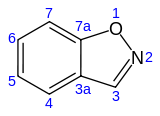Benzisoxazole
 |
|||
|
|
|||
| Names | |||
|---|---|---|---|
|
Preferred IUPAC name
1,2-Benzisoxazole
|
|||
| Other names
Benzo[d]isoxazole; Indoxazine
|
|||
| Identifiers | |||
|
3D model (Jmol)
|
|||
| ChEBI | |||
| ChemSpider | |||
|
PubChem CID
|
|||
|
|||
|
|||
| Properties | |||
| C7H5NO | |||
| Molar mass | 119.12 g·mol−1 | ||
| Appearance | Colorless liquid | ||
| Density | 1.18 g/cm3 | ||
| Boiling point | 35 to 38 °C (95 to 100 °F; 308 to 311 K) (at 2.67 hPa) 101-102 °C (at 2 kPa) |
||
| Hazards | |||
| S-phrases (outdated) | S24/25, S28A, S37, S45 | ||
| Flash point | 58 °C (136 °F; 331 K) | ||
|
Except where otherwise noted, data are given for materials in their standard state (at 25 °C [77 °F], 100 kPa).
|
|||
|
|
|||
| Infobox references | |||
1,2-Benzisoxazole is an aromatic organic compound with a molecular formula C7H5NO containing a benzene-fused isoxazole ring structure. The compound itself has no common applications; however, functionalized benzisoxazoles and benzisoxazoyls have a variety of uses, including pharmaceutical drugs such as some antipsychotics (including risperidone, paliperidone, ocaperidone, and iloperidone) and the anticonvulsant zonisamide.
Its aromaticity makes it relatively stable; however, it is only weakly basic.
Benzisoxazole may be prepared from inexpensive salicylaldehyde, via a base catalyzed room temperature reaction with hydroxylamine-O-sulfonic acid.
...
Wikipedia


